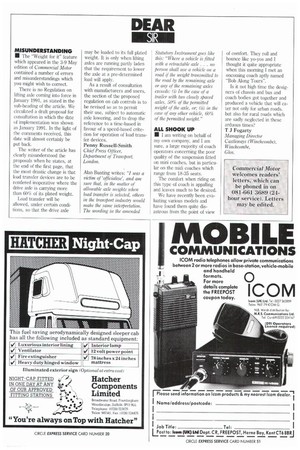DEAR
Page 57

If you've noticed an error in this article please click here to report it so we can fix it.
SIR
MISUNDERSTANDING IN The "Weight for it" feature which appeared in the 3-9 May edition of Commercial Motor contained a number of errors and misunderstandings which you might wish to correct.
There is no Regulation on lifting axle coming into force in January 1991, as stated in the sub-heading of the article. We circulated a draft proposal for consultation in which the date of implementation was shown as January 1991. In the light of the comments received, this date will almost certainly be put back.
The writer of the article has clearly misunderstood the proposals when he states, at the end of the first page, that the most drastic change is that load transfer devices are to be rendered inoperative where the drive axle is carrying more than 60% of its plated weight.
Load transfer will be allowed, under certain conditions, so that the drive axle may be loaded to its full plated weight. It is only when lifting axles are running partly laden that the requirement to lower the axle at a pre-determined load will apply.
As a result of consultation with manufacturers and users, the section of the proposed regulation on cab controls is to be revised so as to permit their use, subject to automatic axle lowering, and to drop the reference to a time-based in favour of a speed-based criterion for operation of load transfer devices.
Penny Russell-Smith
Chief Press Officer, Department of Transport, London.
Statutory Instrument goes like this: "Where a vehicle is fitted with a retractable axle. . no person shall use a vehicle on a road if the weight transmitted to the road by the remaining axle or any of the remaining axles exceeds: (i) In the case of a trailer with two closely spaced tales. 50% of the permitted weight of the axle, or; (ii) in the case of any other vehicle, 60% of the permitted weight."
• I am writing on behalf of my own company, and I am sure, a large majority of coach operators concerning the poor quality of the suspension fitted on mini coaches, but in particular on the midi coaches which range from 18-35 seats.
The comfort when riding on this type of coach is appalling and leaves much to be desired.
We have recently been evaluating various models and have found them quite disastrous from the point of view of comfort. They roll and bounce like yo-yos and I thought it quite appropriate when this morning I met an oncoming coach aptly named "Bob Along Tours".
Is it not high time the designers of chassis and bus and coach bodies got together and produced a vehicle that will cater not only for urban roads. but also for rural roads which are sadly neglected in these arduous times?
T J Fogarty Managing Director Castleways (Winchcombe), Winchcombe, Glos.




































































































